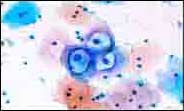toh
Cytopathology
Welcome to the Cytopathology Section of the Division of Anatomical Pathology. Diagnostic cytopathology involves the interpretation of cells that are spontaneously exfoliated or are removed from tissue by abrasion or fine needle aspiration biopsy (FNAB).
The cytopathology service at The Ottawa Hospital offers a comprehensive cytodiagnostic, screening and consultative service, including examination of approximately 14,000 gynecological (Pap smear) specimens, 6,500 non-gynecological specimens, and 3,200 fine needle aspiration biopsies, annually. The service is staffed by cytopathologists, cytotechnologists, and cytotechnicians.
The cytopathology service has an outstanding quality assurance program that consists of correlating all current cytology specimens with surgical pathology specimens. Our goal is to achieve accurate and cost-effective cytologic diagnosis in a timely manner. The section also provides training for pathology residents and cytotechnology students.
Fine Needle Aspiration Biopsy (FNAB)
Fine needle aspiration biopsy (FNAB) is a simple, quick, non-invasive, cost- effective, and most importantly, accurate method for diagnosis of cancer. However, it is also used to diagnose benign tumours and inflammatory / infectious disease. Using the morphology and ancillary techniques such as immunocytochemistry helps to make a definitive diagnosis in a non-invasive way, therefore, decreasing the number of invasive and more costly diagnostic interventions. One example of the value of FNAB is the screening and diagnosis of patients with thyroid nodules. Thyroid nodules are common and FNAB of the thyroid saves many patients from unnecessary surgery.
It is a simple procedure, requiring minutes to perform, while providing a diagnosis or significant clinical information in over 90% of cases. Clinicians aspirate almost any superficial palpable lesions, such as lumps in the breast, lymph nodes, soft tissue, etc. Under radiologic guidance, radiologists aspirate deep-seated lesions from lung, liver, pancreas, etc, with adequacy assessment by cytotechnologists.
PAP Smear
For half a century the Pap test has contributed to a marked decline in the morbidity and mortality of cervical cancer. This test is still one of the very few tests available which has the ability to prevent cancer rather than simply detect it. We use a “state-of-the-art” liquid-based cytology screening test. The advantage of liquid-based cytology testing is that one can perform Hybrid Capture assay for HPV from the same specimen, if the latter is deemed necessary. The ability to do cytology and HPV testing on a single specimen results in decreased patient visits and procedures, minimizes patient anxiety, and saves time and resources. We use the new Bethesda System for reporting of these specimens.

Three cells show changes
of HPV infection
Non-Gynecologic Cytopathology
Non-gynecologic cytology is performed primarily for the diagnosis of cancer. Non-gynecologic samples that lend themselves to cytology evaluation include: effusions (pleural, abdominal, pericardial), cerebral spinal fluid, sputum, urine, and washings/brushings (bronchus, esophagus, stomach, etc.).
Last updated on: June 20th, 2017


 To reset, hold the Ctrl key, then press 0.
To reset, hold the Ctrl key, then press 0.